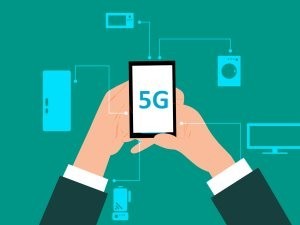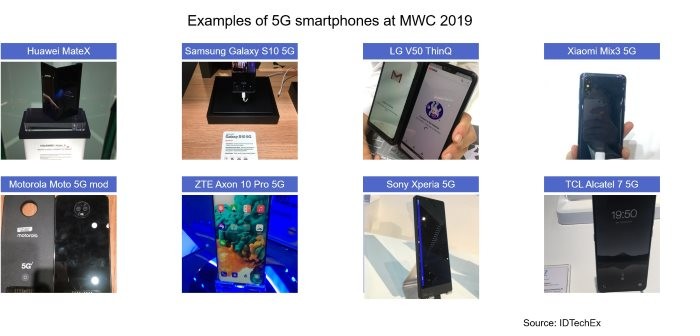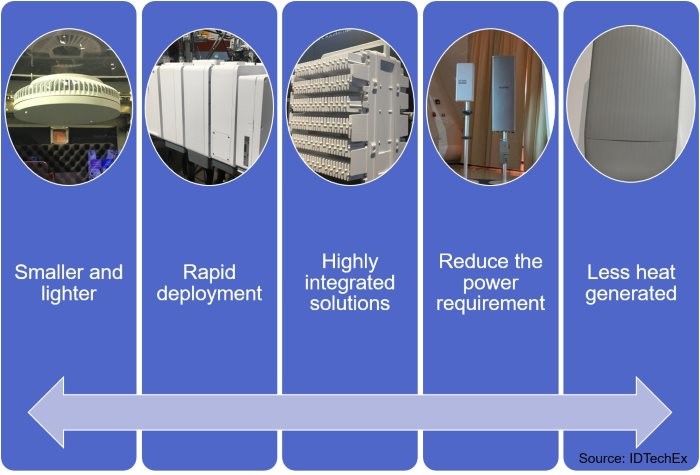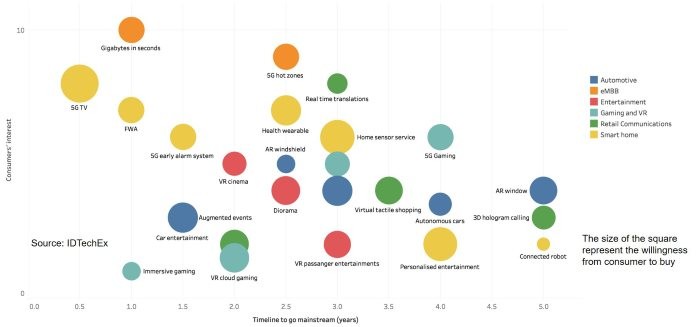2019 marks the year for 5G: Highlights from Mobile World Congress (MWC) 2019
Author: Dr Luyun Jiang, Technology Analyst, IDTechEx

2019 is the year 5G networks will come to life and 5G smartphones will become commercially available. In this article, we will focus on the exhibitions regarding 5G technologies, from the hardware to vertical applications, at Mobile World Congress (MWC) 2019. More information can be found in the brand new 5G report from IDTechEx Research, '5G Technology, Market and Forecast 2019-2029'.
Highlight 1: 5G smartphone
Numerous manufacturers of smartphones either launched or demonstrated prototypes of their 5G handsets at this year's Mobile World Congress. Some examples of the 5G smartphone at MWC 2019 are shown in Figure 1. The first markets welcoming 5G smartphone include America, Europe and Korea, followed by China and Japan.
While many of the handsets support sub-6GHz 5G capabilities, they omitted mmWave functionality since most carriers are not going to support this feature in 2019. America is the key region to start 5G mmWave function. Verizon demonstrated three smartphones to support their mmWave service, which are Motorola mod, LG V50 ThinQ and Samsung Galaxy S10 5G. 5G Technology, Market and Forecast 2019-2029 (www.IDTechEx.com/5G) includes the technique and market details for the coming 5G smartphones.
The price for the 5G smartphone in 2019 is expected to be higher, various from 800-2600 USD (Huawei MateX at 2299 Euro, Samsung Galaxy S10 5G about 1.5 M KRW, and LG V50 ThinQ around 800-1000 USD). However, the price might drop below 500 USD in 2020 when more players enter.

Figure 1: Examples of 5G smartphones at MWC 2019.
Source: IDTechEx Research - 5G Technology, Market and Forecast 2019-2029.
Highlight 2: 5G network
The key vendor, including Ericsson, Huawei, Nokia, ZTE and Samsung all demonstrated their 5G network solutions for low band, mid-band and high band 5G. The innovations are around one question: how to make it easier and cheaper for carriers to deploy the 5G network. The trends for network solution innovations are summarised in Figure 2.
One example is the new Huawei 5G station with Tiangang chipset. "This chip also brings revolutionary improvements in active antenna units (AAUs), with 50% smaller, 23% lighter. 5G base stations can be deployed in just half the time it took to install a 4G base station", according to Huawei. Nokia introduced a new cooling system to get rid of the heavy water tank and make the whole system lighter and easier to deploy. Ericsson launched a new 5G small cell "5G radio dot" and promoted the fixed wireless access (FWA) which can be installed in just a few minutes. For more information in 5G network ranging from the chipset, active antennas, RF module, optical module, base station, small cells and more, please see 5G Technology, Market and Forecast 2019-2029.

Figure 2: Trends in 5G network: easier for carriers to deploy.
Source: IDTechEx Research - 5G Technology, Market and Forecast 2019-2029.
Highlight 3: the race of 5G contract
At MWC 2019, the network vendors, including Ericsson, Huawei, Nokia and Samsung signed 12 contracts in total, as listed on the left. Ericsson and Huawei both gained four deals, followed by Nokia with three and Samsung with one, as listed in table 1.
Huawei claimed to have signed more than 30 5G deals globally, although it has not been willing or able to share full details. Ericsson disclosed the names of their 5G customers who have signed formal contracts, in a total of 14 (increased to 16 by March 2019). Note that Ericsson's CEO said the company had won roughly 50% of the world's 5G contracts so far (Feb. 2019). This number might refer to the official contracts number, but not the agreement number.
Find the position of each key vendor including Nokia, Samsung and ZTE in the IDTechEx Research report 5G Technology, Market and Forecast 2019-2029.

Highlight 4: booming of 5G vertical applications
5G will not only accelerate the growth and expansion of telecom; it will also redefine industries such as automotive, entertainment, computing, and manufacturing. It is believed that 5G network technology will ultimately alter user experiences and business efficiencies in dramatic ways. The 5G ecosystem will be enormous, and so will the opportunities.
The explored 5G vertical applications include, but not limited to, AR/VR experience, personalised entertainment, connected cars, remote delivery of health care services, smart factory and the internet of things (IoT) — including smart cities, smart homes, and wearables.
Figure 3 shows a holistic view of 5G vertical applications for consumers, including when we will expect such a service to be commercialised available, how much interest from the consumer's side and the willingness from consumers to buy.
5G Technology, Market and Forecast 2019-2029 provides more information on 5G vertical applications and comprehensive case studies such as the smart factory, connected car, remote surgery and more.

Figure 3: 5G for consumers overview.
Source: IDTechEx Research - 5G Technology, Market and Forecast 2019-2029.
Summary
2019 marks the year for 5th-Generation Wireless Systems (5G) to come to life, with large scale 5G roll-out and more than thirty 5G devices rushing into the market, including 5G smartphones and more. IDTechEx Research forecast the 5G market is expected to be around $700 bn by 2030, with main contributions coming from mobile services, fixed wireless services and narrow-band IoT. The new 5G report from IDTechEx provide a holistic view of 5G technology and help to point out the 5G market opportunities.
Contact the IDTechEx Research team at research@IDTechEx.com to find out more at www.IDTechEx.com/5G.




